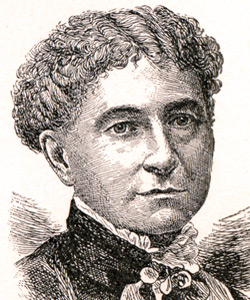Amelia Jenks Bloomer (Amelia Jenks Bloomer)

Amelia Bloomer was born in 1818 in Homer, New York. Bloomer came from a family of modest means and received only a few years of formal education in the local district school. After a brief stint as a school teacher at the age of 17, she decided to relocate, and moved in with her newly married sister Elvira, then living in Waterloo. Within a year she had moved into the home of the Oren Chamberlain family to act as the live-in governess for their three youngest children. When she was 22, she married attorney Dexter Bloomer who encouraged her to write for his New York newspaper, the Seneca Falls County Courier.
She spent her early years in Cortland County, New York. Bloomer and her family moved to Iowa in 1852. She died at Council Bluffs, Iowa. She is commemorated together with Elizabeth Cady Stanton, Sojourner Truth, and Harriet Ross Tubman in the calendar of saints of the Episcopal Church on July 20. Her home at Seneca Falls, New York, known as the Amelia Bloomer House, was listed on the National Register of Historic Places in 1980.
In 1848, Bloomer attended the Seneca Falls Convention, an influential women’s rights convention in the U.S. The following year, she began editing the first newspaper for women, The Lily. It was published biweekly from 1849 until 1853. The newspaper began as a temperance journal, but came to have broad mix of contents ranging from recipes to moralist tracts, particularly when influenced by temperance activist and suffragette Elizabeth Cady Stanton and Susan B. Anthony. Bloomer felt that because women lecturers were considered unseemly, writing was the best way for women to work for reform. Originally, The Lily was to be for “home distribution” among members of the Seneca Falls Ladies Temperance Society, which had formed in 1848, and eventually had a circulation of over 4,000. The paper encountered several obstacles early on, and the Society’s enthusiasm died out. Bloomer felt a commitment to publish and assumed full responsibility for editing and publishing the paper. Originally, the title page had the legend “Published by a committee of ladies.” But after 1850 – only Bloomer’s name appeared on the masthead. This newspaper was a model for later periodicals focused on women’s suffrage.
Bloomer described her experience as the first woman to own, operate and edit a news vehicle for women:
It was a needed instrument to spread abroad the truth of a new gospel to woman, and I could not withhold my hand to stay the work I had begun. I saw not the end from the beginning and dreamed where to my propositions to society would lead me.
In her publication, Bloomer promoted a change in dress standards for women that would be less restrictive in regular activities.
The costume of women should be suited to her wants and necessities. It should conduce at once to her health, comfort, and usefulness; and, while it should not fail also to conduce to her personal adornment, it should make that end of secondary importance.
In 1851, New England temperance activist Elizabeth Smith Miller (aka Libby Miller) adopted what she considered a more rational costume: loose trousers gathered at the ankles, like women’s trousers worn in the Middle East and Central Asia, topped by a short dress or skirt and vest. The costume was worn publicly by actress Fanny Kemble. Miller displayed her new clothing to Stanton, her cousin, who found it sensible and becoming, and adopted it immediately. In this garb Stanton visited Bloomer, who began to wear the costume and promote it enthusiastically in her magazine. Articles on the clothing trend were picked up in The New York Tribune. More women wore the fashion which was promptly dubbed The Bloomer Costume or “Bloomers”. However, the Bloomers were subjected to ceaseless ridicule in the press and harassment on the street. Bloomer herself dropped the fashion in 1859, saying that a new invention, the crinoline, was a sufficient reform that she could return to conventional dress.
Bloomer remained a suffrage pioneer and writer throughout her life, writing for a wide array of periodicals. Although Bloomer was far less famous than some other suffragettes, she made many significant contributions to the women’s movement — particularly concerning dress reform and the temperance movement. Bloomer led suffrage campaigns in Nebraska and Iowa, and served as president of the Iowa Woman Suffrage Association from 1871 until 1873.
Born
- May, 27, 1818
- USA
- Homer, New York
Died
- December, 30, 1894
- USA
- Council Bluffs, Iowa
Cemetery
- Fairview Cemetery
- Council Bluffs, Iowa
- USA





